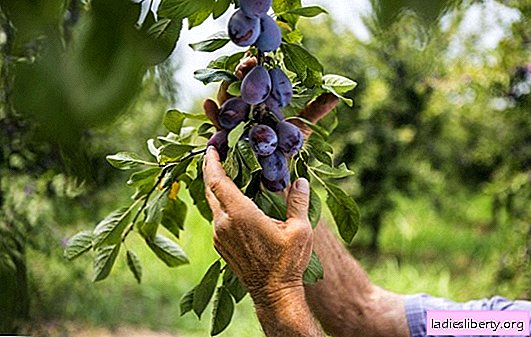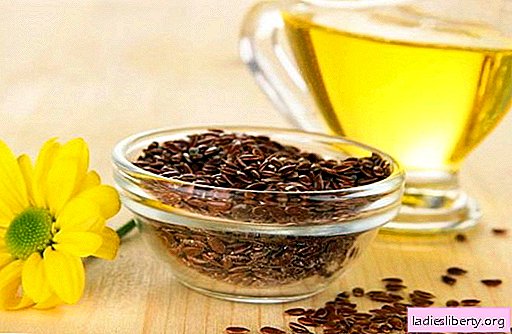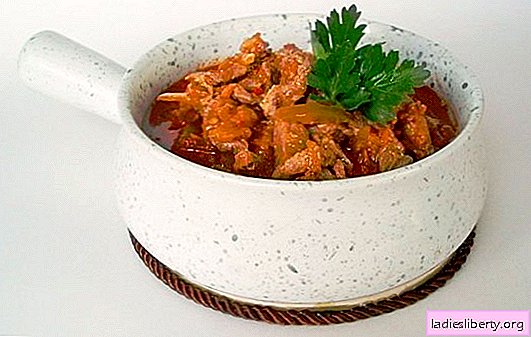
Plum is a favorite tree of all with tasty fruits. In the gardens of Russia, she takes an honorable second place after cherries.
Scientists have proven that home plum is a spontaneous hybrid between thorns and cherry plums. She inherited the best qualities from her parents: from the turn - unpretentiousness and winter hardiness, from cherry plum - juicy and sweet fruits.
The plum pulp is dense and tasty, combining marmalade pulp, aroma and sugar content.
This breed is famous for productivity, rapid growth and early maturity. It begins bearing fruit in the third to fifth year. Already at the age of five or six years, the yield reaches 25-30 kg per tree, by ten - twelve years - up to fifty kilograms.
Plum is quite winter-hardy and frost-resistant, however, according to these indicators, it is significantly inferior to cherry or apple tree. Temperature extremes and winter thaws are especially dangerous for her, as she is prone to warming.
Plum: planting and care
Seat selection
For better pollination, it is advisable to have 2-3 varieties on the site. When choosing a landing site, the biological characteristics of the culture must be taken into account.
• The roots of the plant lie superficially, in the soil layer no deeper than sixty centimeters.
• A distinctive feature of plums - a love of moisture. It is easier to tolerate excess moisture than its lack.
• It can put up with the proximity of groundwater if it is located no closer than 1-1.5 meters from the surface of the earth.
• Low soil requirements. However, to obtain a good harvest and high-quality fruits, nutritious loamy soils are needed.
• Acidic soils for plum are destructive; on them it becomes sick, withers, and sharply reduces productivity. Plum develops well in fertile soils with a pH of 6.5-7.5.
Plum planting
The timing of planting the plum and further care are determined by the climatic zone of its cultivation.
If it is recommended to plant and replant a plum in the middle lane only in the spring, then in the south it is better to plant trees in the fall and even in the winter (in December).
The distance between the seedlings depends on the type of plum and rootstock. In industrial gardens, approximate distances:
• between trees in a row - from three to four meters;
• between rows - from five to seven.
A pit is prepared for planting in size:
• diameter - 70 cm;
• depth - 50 centimeters.
Introduce into the pit:
• up to 15 kg of organics;
• 0.4 kg of superphosphate;
• 60-80 g of potassium salt;
• 400 g sifted wood ash;
• 40-60 g of potassium chloride;
• 400-500 g of dolomite flour.
All fertilizers are pre-mixed with the ground.
A seedling with straightened roots is placed in the center of the pit without deepening.
Landing

Then they evenly fill the soil with a mixture and tamp the soil with your hands. The root neck is placed 3-5 cm above the ground. In this case, after the subsidence of the soil, it will be at the right level.
If the planting is not deep enough, the roots of the seedling may be on the surface. The root shoot will go from the stock. Deepening of the root neck will cause root formation at the rootstock. That is, the varietal seedling will go "to its roots." This can lead to a decrease in winter hardiness. However, in the event of the death of a tree in the frosty winter, it will give rise to a cultivated variety. Plum will recover without additional vaccination.
After planting, each seedling is watered with approximately three buckets of water. The earth around the tree is mulched. If necessary, tie to a stake.
The next stage after planting is caring for the plum.
Plum dressing
If the necessary organic fertilizers were introduced during planting, then in the first year the trees are not fed.
In the second growing season, foliar urea top dressing is used in the first and third decades of June.
In the following years, up to fruiting, fertilizers are introduced into circular furrows 6-10 cm deep around the near-trunk circle with the following solutions.
• In May - 2 tbsp. urea and 2 tbsp. tablespoons of liquid sodium humate in 10 liters of water.
• In June - 3 tbsp. tablespoons nitrofoski per 10 liters of water.
• In August-early September - 2-3 tbsp. tablespoons of superphosphate and potassium sulfate in 10 liters of water.
Note: consumption per 1 tree is 15-20 liters of solution.
In the fruiting garden, the dose of fertilizers is increased and applied per 1 sq. Km. m trunk circle:
• 10 kg of organics;
• 25 g of urea;
• 60 g of superphosphate;
• 20 g of potassium chloride.
Nitrogen plum dressing is used only in spring, phosphorus-potassium fertilizers, manure and compost - in the autumn for digging. Acidic soils must be lime every five years.
Overfeeding plums with nitrogen leads to a deterioration in the quality of the fruit, weakening winter hardiness due to prolonged vegetation.
• With potassium deficiency, the leaves curl and turn brown.
• The lack of plant magnesium is expressed in the browning of leaf veins.
• With nitrogen starvation, the leaves turn pale green.
If light green leaves are found, the tree crown and leaves urgently need to be sprayed with an aqueous solution (0.3-0.4%) of ammonium nitrate or urea.
Any feeding of the plum by the pit method is possible and effective, followed by abundant watering
Watering plums
In the spring, there is enough moisture in the soil and there is no need for watering.
During the formation of fruits, the plum experiences the greatest need for water. This is approximately June - August. The rate of plum irrigation is 50-60 liters per square meter of crown projection.
Sample irrigation schedule:
1. during the growth of the ovary and shoots;
2. 1-2 weeks before harvest;
3. after harvesting (if there is no rain);
4. in October (in dry autumn).
Before ripening, watering should be limited. Excessive moisture in the plum may crack the fruit.
It should be watered without waiting for the soil to dry, it is best under the root. Lack of watering in a dry summer can cause the ovaries to fall off the plum.
Prune pruning
Plum trees are usually pruned according to a standard sparse-tier pattern. Although in intensive gardens on stunted rootstocks, flat-type or spindle-shaped crowns are possible.
• After planting, seedlings are pruned only in the spring, regardless of how long they planted in the garden. Unbranched annuals are shortened to seventy centimeters.
• In the second year, 3-5 skeletal branches are chosen. Shorten them. The length of the lower branch should be 60-70 cm. The conductor is trimmed twenty centimeters higher than the other branches. Skeletal branches are laid 30-35 cm apart.
Pruning

Pruning a young plum should be minimal. Thickening branches are removed, shoots that are knocked out of the crown structure are shortened.
For fruiting plum trees, pruning is a method of preventing weakening growth.
If young shoots grow more than 40 cm, you can limit yourself to thinning. With a smaller increase, shortening is used. The pruning of branches is the stronger, the smaller the growth.
With radical rejuvenation, skeletal branches are cut to strong tops.
Plum grafting
This culture can be instilled in all known ways. Of all the stone fruits, plum is the most unpretentious in grafting. The operation of engraftment of the scion to stock is carried out at different times by various methods.
The main methods for vaccinating plums are budding and copulation.
Copulation (grafting with a graft) is performed in the spring before buds open. Stone fruits are planted first, as soon as the weather permits. In the south, you can make copies in the "February windows", without fear of return frosts.
Copulation

Crowning is carried out in the summer, usually in August. Timing depends on the climate zone.
Budding

In summer, budding is performed in the morning or evening in cool hours. Ideal conditions for this event are cloudy weather without rain.
Other plum breeding methods
Plum seeds are propagated to produce stocks or in breeding.
Propagation by root shoots

Root shoots are bred exclusively by root trees. You can plant a cultivar on the overgrown game. To obtain varietal shoots from the grafted tree when planting a seedling, the grafting site is buried.











